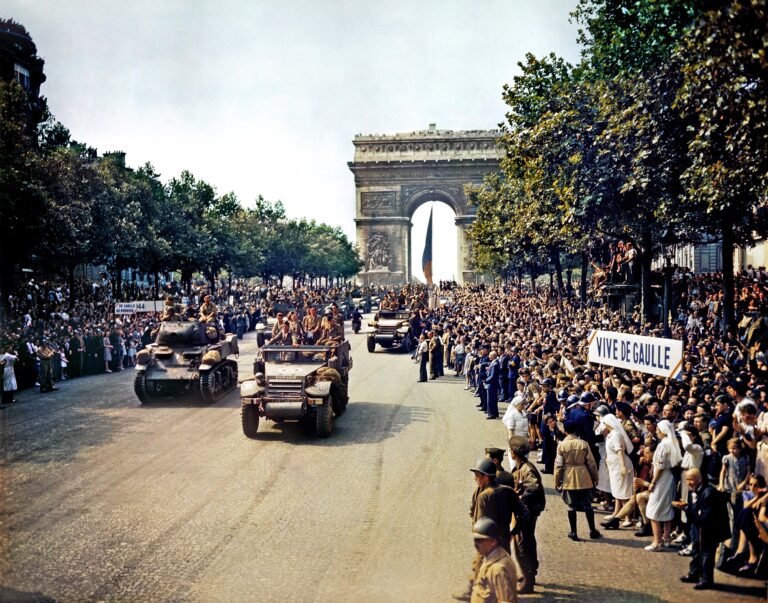Exploring the Strategic Pivots: France ’44 and the Wet Gap Crossings at Nancy
In the summer of 1944, the Allied forces found themselves engaged in a crucial campaign to liberate France from Nazi occupation. Among the myriad battles that shaped this pivotal moment in history, the wet gap crossings at Nancy stand out as a testament to military strategy and audacity. A detailed examination of these operations reveals not only the tactical challenges faced by commanders but also the ingenuity and resilience of the soldiers involved. This article delves into the complexities of the wet gap crossings at Nancy, shedding light on their critical role in the broader context of the liberation of France and the eventual defeat of German forces in World War II. As we revisit this key chapter of military history, we uncover the bravery and innovation that defined this crucial period of the war.
Strategic Significance of the Wet Gap Crossings in France ’44
In the liberation of France in 1944, the wet gap crossings near Nancy played a crucial role in the Allied strategy, acting as both physical barriers and tactical opportunities. The region’s waterways, particularly the Meurthe and Moselle rivers, presented formidable challenges for advancing forces. The ability to secure and cross these gaps required meticulous planning and execution, thereby influencing the momentum of the campaign in Eastern France. The intense battles fought at these crossings underscored their importance in facilitating troop movement and supply line establishment, which ultimately contributed to the encirclement of German forces in the region. Key factors influencing this strategic significance included:
- Terrain Familiarity: Local knowledge aided Allied forces in planning effective assaults.
- Logistical Coordination: Efficient supply routes were vital for sustained military operations.
- Air and Ground Support: Effective use of air superiority provided cover and disrupted enemy movements.
The wet gap crossings not only affected immediate tactical maneuvers but also shaped the broader operational outlook of the Allies. As troops advanced, the command centers were compelled to adapt to the fluid battlefield realities, employing innovative tactics for overcoming the natural obstacles presented by the French landscape. In this context, the crossings became sites of intense firefights, whereby both sides sought to capitalize on the defensive advantages they afforded. Significant implications of these engagements included:
| Engagement | Outcome | Impact |
|---|---|---|
| Battle of the Meurthe | Allied Victory | Secured eastern flank |
| Crossing of the Moselle | German Retreat | Disrupted enemy supply lines |
Operational Challenges Faced by Allied Forces at Nancy
The operational landscape faced by Allied forces at Nancy during the critical summer of 1944 was fraught with significant hurdles that tested their strategic and tactical capabilities. Chief among these was the challenging terrain, characterized by extensive marshlands and rivers, which severely restricted movement and logistics. As rain persisted, roads became impassable, impacting the supply chain and forcing units to adapt quickly to the evolving conditions. Among the major challenges were:
- Weather Conditions: Continuous rain created muddy environments, complicating vehicle movement and troop maneuvers.
- Infrastructure Damage: Previous combat had devastated key bridges and roads, necessitating improvised repair efforts.
- Enemy Resistance: Well-entrenched German positions made any advance costly, demanding careful planning and coordination among units.
To address these issues, commanders devised innovative strategies, relying on engineering units to spearhead bridge reconstruction efforts. A strategic priority was to secure key crossing points along the Meurthe River, enabling a full-scale advance into Lorraine. Despite these efforts, the challenges remained daunting; logistical strains severely hampered the movement of reinforcements and supplies. Below is a summary of the critical measures taken:
| Measure | Description |
|---|---|
| Bridge Reconstructions | Rapid repairs to facilitate troop and supply movements. |
| Use of Amphibious Vehicles | Enhanced capabilities to traverse flooded areas. |
| Coordinated Air Support | Airstrikes to weaken enemy positions and clear paths. |
Lessons Learned from the Crossings: Tactical Insights for Future Missions
The wet gap crossings at Nancy during France ’44 provided critical lessons that can be applied to future military operations. Among the standout tactics were the integration of joint forces and the necessity of real-time reconnaissance. Commanders quickly learned that coordinating between infantry, armor, and engineering units was vital for overcoming both physical obstacles and enemy resistance. Using air support strategically facilitated rapid movement and disruption of enemy lines, showcasing that well-timed air strikes could create essential windows for ground forces.
Additionally, effective logistics management emerged as a key takeaway. Troop supply chains must be adaptable, ensuring that essential materials such as ammunition and medical supplies can be delivered promptly to support ongoing combat operations. The experiences at Nancy underscored the importance of training in wet gap operations, emphasizing the need for amphibious capabilities and specialized equipment in planning phases. Future missions should also incorporate lessons learned concerning troop morale and the psychological effects of operating in challenging environments, ensuring that soldiers are mentally prepared for the rigors of similar operations.
Recommendations for Modern Military Strategy Based on Historical Analysis
The analysis of the wet gap crossings near Nancy in 1944 offers critical insights into modern military strategy. Firstly, it underscores the importance of combined arms operations, where armored units, infantry, and air support are synergistically utilized. This strategy enhances operational effectiveness, particularly in complex environments where cross-river maneuvers or challenging terrains are involved. Modern military leaders must prioritize joint training exercises that reflect these historical lessons, ensuring that units can efficiently coordinate through the integration of technology and tactics.
Moreover, the operational flexibility exhibited by Allied forces during this campaign highlights the need for adaptive decision-making in military doctrine. Commanders today should cultivate a culture of agile responses to rapidly changing battlefield conditions. This includes implementing real-time intelligence and employing decentralized command structures that facilitate swift tactical adjustments. The legacy of the Nancy crossings illustrates that positioning resources strategically, coupled with the ability to pivot in response to unforeseen challenges, can be the determining factor in achieving mission success.
The Way Forward
In conclusion, the strategic significance of the Wet Gap Crossings at Nancy in 1944 cannot be overstated. As detailed in our exploration of the intense military operations that unfolded, these crossings served as a pivotal point in the Allied campaign to liberate France from Nazi occupation. The challenges faced by soldiers on the ground, coupled with the innovative tactics employed to overcome them, underscore the complexity of warfare during this critical period. As we reflect on these events, it’s essential to recognize not just the military ingenuity displayed, but also the profound human cost of such operations. The lessons learned from the Wet Gap Crossings at Nancy continue to resonate in modern military strategy and serve as a reminder of the resilience and determination displayed by those who fought for freedom. For further insights into this significant chapter in World War II history, we encourage readers to explore more at armyupress.army.mil.




